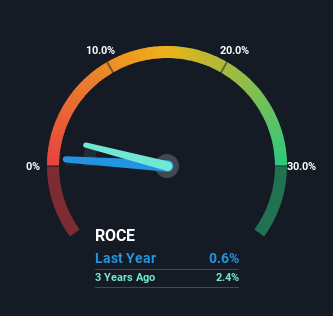- India
- /
- Electric Utilities
- /
- NSEI:DPSCLTD
India Power (NSE:DPSCLTD) Could Be Struggling To Allocate Capital
When researching a stock for investment, what can tell us that the company is in decline? Businesses in decline often have two underlying trends, firstly, a declining return on capital employed (ROCE) and a declining base of capital employed. This reveals that the company isn't compounding shareholder wealth because returns are falling and its net asset base is shrinking. In light of that, from a first glance at India Power (NSE:DPSCLTD), we've spotted some signs that it could be struggling, so let's investigate.
Return On Capital Employed (ROCE): What Is It?
For those that aren't sure what ROCE is, it measures the amount of pre-tax profits a company can generate from the capital employed in its business. The formula for this calculation on India Power is:
Return on Capital Employed = Earnings Before Interest and Tax (EBIT) ÷ (Total Assets - Current Liabilities)
0.0063 = ₹96m ÷ (₹20b - ₹5.3b) (Based on the trailing twelve months to December 2023).
Thus, India Power has an ROCE of 0.6%. Ultimately, that's a low return and it under-performs the Electric Utilities industry average of 7.5%.
Check out our latest analysis for India Power

While the past is not representative of the future, it can be helpful to know how a company has performed historically, which is why we have this chart above. If you want to delve into the historical earnings , check out these free graphs detailing revenue and cash flow performance of India Power.
What Does the ROCE Trend For India Power Tell Us?
We are a bit anxious about the trends of ROCE at India Power. Unfortunately, returns have declined substantially over the last five years to the 0.6% we see today. In addition to that, India Power is now employing 70% less capital than it was five years ago. The fact that both are shrinking is an indication that the business is going through some tough times. Typically businesses that exhibit these characteristics aren't the ones that tend to multiply over the long term, because statistically speaking, they've already gone through the growth phase of their life cycle.
While on the subject, we noticed that the ratio of current liabilities to total assets has risen to 26%, which has impacted the ROCE. Without this increase, it's likely that ROCE would be even lower than 0.6%. Keep an eye on this ratio, because the business could encounter some new risks if this metric gets too high.
The Bottom Line
To see India Power reducing the capital employed in the business in tandem with diminishing returns, is concerning. Despite the concerning underlying trends, the stock has actually gained 36% over the last five years, so it might be that the investors are expecting the trends to reverse. Either way, we aren't huge fans of the current trends and so with that we think you might find better investments elsewhere.
One more thing, we've spotted 1 warning sign facing India Power that you might find interesting.
While India Power isn't earning the highest return, check out this free list of companies that are earning high returns on equity with solid balance sheets.
New: AI Stock Screener & Alerts
Our new AI Stock Screener scans the market every day to uncover opportunities.
• Dividend Powerhouses (3%+ Yield)
• Undervalued Small Caps with Insider Buying
• High growth Tech and AI Companies
Or build your own from over 50 metrics.
Have feedback on this article? Concerned about the content? Get in touch with us directly. Alternatively, email editorial-team (at) simplywallst.com.
This article by Simply Wall St is general in nature. We provide commentary based on historical data and analyst forecasts only using an unbiased methodology and our articles are not intended to be financial advice. It does not constitute a recommendation to buy or sell any stock, and does not take account of your objectives, or your financial situation. We aim to bring you long-term focused analysis driven by fundamental data. Note that our analysis may not factor in the latest price-sensitive company announcements or qualitative material. Simply Wall St has no position in any stocks mentioned.
About NSEI:DPSCLTD
India Power
Engages in the generation and distribution of electricity in India.
Adequate balance sheet average dividend payer.
Similar Companies
Market Insights
Community Narratives



